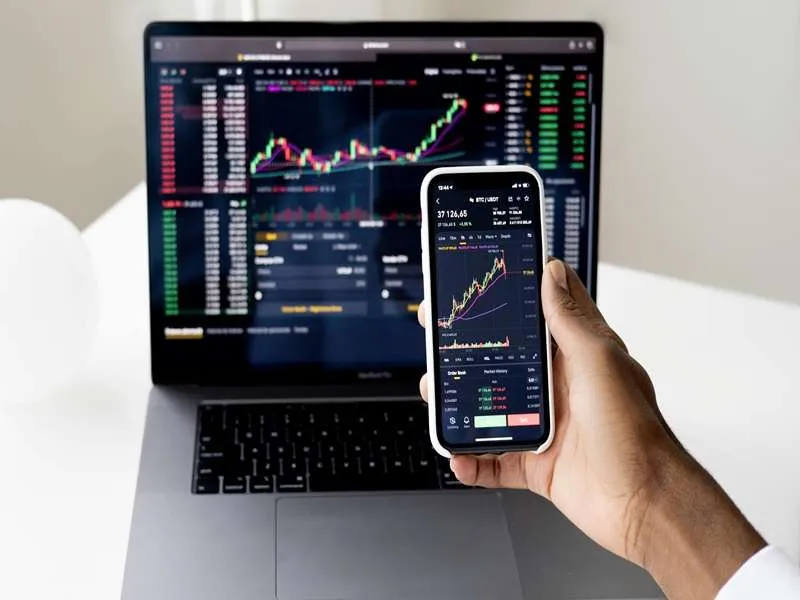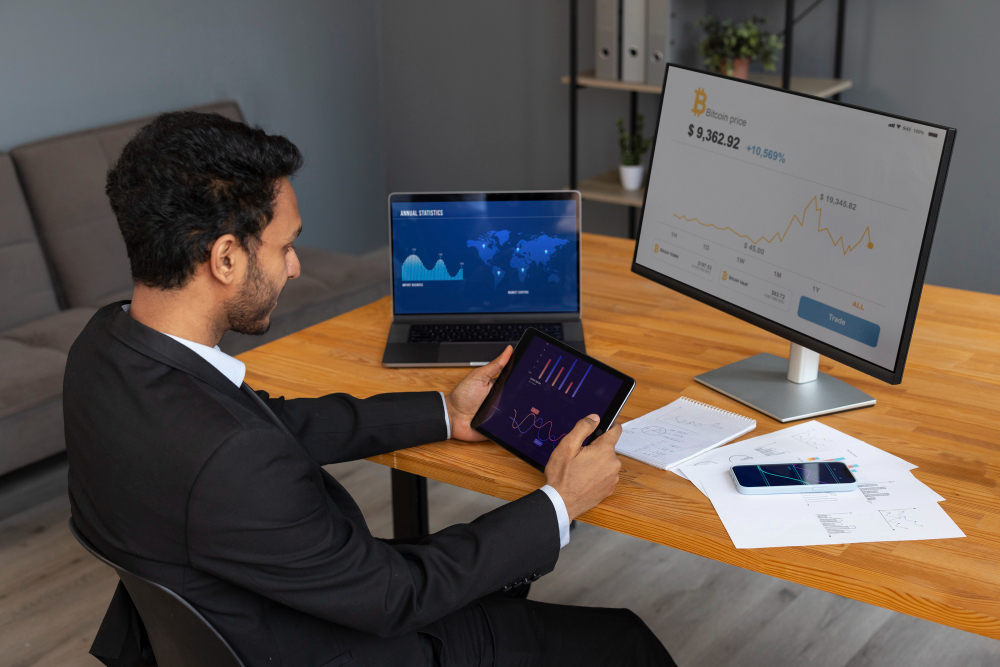How Much Can You Make Day Trading With 100K
How much can you make day trading with 100K? Discover real earnings potential, risks, and what influences your returns.

Considering day trading with a $100k bankroll? It’s a thrilling prospect, but also a challenge. Success hinges on knowing how much you can realistically make. This guide will break down potential returns, help you sidestep pitfalls, and maximize your gains. One strategy worth exploring is smart money trading, which focuses on tracking institutional activity and understanding how the "big players" move the markets. By aligning your trades with smart money rather than fighting against it, you can increase your odds of consistent profitability. Let's dive into the art of earning smart money.
One way to get ahead? Check out Aqua Funded's funded trading program. It's a game-changer.
How Much Money Do You Need for Day Trading

Legal Minimums: Pattern Day Trader Rule for U.S. Stocks
The Pattern Day Trader (PDT) Rule, enforced by FINRA, sets a $25,000 minimum account balance for those who make four or more day trades in five business days in the U.S. stock market. This rule applies to margin accounts trading U.S. equities. If your account balance falls below $25,000, your broker may freeze your account or restrict your trading activities.
Trading Without $25,000: Exploring Alternative Options
If you don’t have $25,000, there are other ways to enter the market:
Use a Cash Account
Avoid PDT restrictions by trading with a cash account. However, remember that you’ll need to wait for the funds to settle, typically two days before reusing them. This is best for low-frequency traders.
Trade in Other Markets
Consider futures, forex, or crypto. You can start futures trading with around $1,000 to $5,000. For forex, initial deposits can range from $100 to $500. Cryptocurrency has no PDT rule, and you can begin with as little as $1,000.
Recommended Starting Capital: Practical Considerations
Realistic starting capital can vary depending on your market of choice:
Stocks
Ideally, $30,000 to $50,000 to absorb drawdowns and cover fees.
Options
Start with $5,000 to $10,000, although it carries a higher risk.
Futures
Commonly, $5,000 to $10,000 is recommended.
Forex
Despite lower offers from brokers, investing $1,000 to $3,000 is a smart move.
Having extra funds helps manage losses, fees, and volatility more safely.
Why More Money Is Better for Day Trading
More capital, even beyond the minimum requirements, has several advantages:
Better Risk Management
You can risk a smaller percentage per trade.
Reduced Leverage Needs
Less chance of a margin call.
Flexibility in Position Sizing
More options for trade sizes.
Less Stress
Less pressure on each trade.
Broker Requirements and Considerations
Brokers can have their minimums, which might be higher. Keep an eye on:
Commissions and Platform Fees
These can add up significantly.
Margin Requirements
Different brokers have varying margin requirements.
Withdrawal Restrictions
Some brokers place limits on how you can access your funds.
Is Day Trading Profitable

The Harsh Reality of Day Trading Losses
Most day traders find themselves at a disadvantage. Research reveals that around 90% of day traders experience losses. For instance, a University of California study found that only 13% of traders generated profits over six months. Another study indicated that a mere 1% could consistently beat the market after accounting for trading costs. While profitability is not impossible, it demands skill, discipline, and a solid strategy.
Unrealistic Expectations of Day Trading Returns
Many traders enter the market with dreams of double-digit monthly returns. However, professional traders at institutions typically aim for a modest annual return of 10-15%. For retail traders, achieving even a consistent 1% daily profit is incredibly challenging. Such returns would theoretically result in over 250% annual gains, but this is nearly impossible to sustain after factoring in costs, taxes, and emotional strain.
Trading Costs: The Silent Profit Killer
Even the most skilled traders can see their profits eroded by transaction costs like commissions, spreads, and slippage. Active trading increases your exposure to fees and poorly executed trades. Even those adept at market timing may find these expenses enough to tip the balance into unprofitability.
Experience Matters, But Not Much
A Taiwanese study found that only 5% of traders remained profitable over a 15-year period. Among frequent traders, just the top 1% achieved consistent profitability. Experience does offer slight improvements, but simply “putting in the time” isn’t a surefire path to success.
The Institutional Edge
Retail traders face a significant disadvantage compared to institutional traders, who benefit from superior technology, faster execution, and substantial capital. Without these resources, the average retail trader has a low likelihood of long-term profitability.
Psychological and Emotional Pitfalls
Even with a strong strategy, emotional and psychological factors such as overtrading, revenge trading, and fear can erode any edge you have. Day trading is highly stressful, and emotional decision-making often leads to losses. Success in trading requires not just skill and strategy, but also emotional discipline.
The Illusion of Survivorship Bias
Survivorship bias skews perceptions of day trading profitability. You frequently hear about successful traders making significant money, but the countless stories of those who failed and quit remain untold. This creates a misleading impression that trading is more profitable than it truly is.
Ready to turn your trading skills into profits without risking your capital? AquaFunded’s funded trading program offers accounts of up to $ 400,000, with flexible trading conditions and a profit split of up to 100%. Join over 42,000 traders who’ve already collected more than $2.9 million in rewards.
Related Reading
- How Much Money Do You Need to Start Trading
- How Long Does It Take to Learn Trading
- What Challenges Do Traders Face?
- Futures vs Stocks Trading
- Why is Trading So Hard
- How to Swing Trade
- How to Multiply Your Money
- How to Start Trading With No Money
How Much Can You Make Day Trading With 100k

Day trading $100,000 is a serious endeavor. While it offers excellent potential, it requires skill and discipline. Most pros aim for monthly returns between 1% and 5%. This means you could earn between $1,000 and $5,000 per month, or between $12,000 and $60,000 annually. Consistently surpassing 5% per month is rare and often involves more risk.
What Factors Impact Your Earnings?
1. Risk Per Trade
Risky behavior can result in substantial losses. Many traders follow the 1% rule, risking $1,000 on each trade with a $ 100,000 account. Some may risk less, around $500, focusing on high-probability setups with tight stop losses. This approach can still yield returns of 1.5 to 2 times the initial investment on winning trades.
2. Win Rate and Risk-Reward Ratio
A trader’s success often hinges on their win rate and risk-reward ratio. Suppose you win 55% of your trades with a 1:2 risk-reward ratio. Out of 20 trades, you might lose 11 for a $11,000 loss but win 9 for an $18,000 gain. This nets you $7,000, but it requires emotionless, disciplined trading.
3. Trading Style
Different styles yield different results. Scalpers execute numerous small trades daily, aiming for small profits. Momentum traders focus on fewer, high-conviction trades, targeting $500 to $2,000 per day. Swing traders typically hold positions for more extended periods, resulting in less consistent daily returns.
The Risk of Loss: Yes, You Can Lose Money
Trading isn’t risk-free. Many traders, even those with six-figure accounts, blow up their funds by overtrading, misusing leverage, or losing emotional control. A few bad trades with poor risk management can erase 10% to 30% of your capital quickly.
Realistic Outcomes for Traders
Conservative traders can earn $ 12,000 to $ 30,000 annually with minimal risk. Moderately aggressive traders can earn $3,000 to $10,000 monthly with excellent risk control and a high win rate. High-risk traders may aim for $60,000 to $100,000 annually, but few can sustain such a high level of income. Unskilled traders can lose substantial portions of their capital, even with $ 100,000.
Ready to turn your trading skills into profits without risking your capital? AquaFunded’s funded trading program offers accounts of up to $ 400,000, with flexible trading conditions and a profit split of up to 100%. Join over 42,000 traders who’ve already collected more than $2.9 million in rewards.
Related Reading
- What Happens if You Blow a Funded Account
- How to Become a Professional Trader
- Best Market to Trade for Beginners
- Tips for Day Trading
- Common Trading Mistakes
- Margin vs Leverage
- Scalping Trading Strategy
- Margin vs Leverage
- Day Trading vs Options
- Best Time Frame for Day Trading
20 Tips for Making Money With Day Trading
.jpeg)
1. Unlock Your Potential with AquaFunded
Leverage your trading skills without putting your own money at risk. AquaFunded offers access to accounts of up to $ 400,000 under the most adaptable trading conditions. With no deadlines, achievable profit targets, and up to 100% profit split, it's an excellent platform for budding day traders. Join a community of over 42,000 traders who’ve already earned more than $2.9 million in rewards. Choose from instant funding or personalized challenge paths, and start trading with confidence.
2. Start Small and Grow Steadily
Resist jumping into large trades right away. Begin with small positions to cushion any early mistakes. This helps you learn the market, build discipline, and gain confidence. Gradually increase your trades once you see consistent positive outcomes, all while keeping risk in check.
3. Protect with Stop-Loss and Take-Profit Orders
Stop-loss orders automatically close a trade at a predetermined loss level, minimizing your downside. Take-profit orders lock in gains before the market turns. Day traders often face fast markets, where hesitation can lead to losses. These orders enforce discipline and prevent emotional mistakes, such as holding onto losing trades or selling winners too soon.
4. Ace the Game with Paper Trading
Paper trading utilizes a simulated trading account to execute trades in real-time, allowing users to practice without risking real money. Beginners need to understand order execution and strategy implementation. This allows you to gain experience and confidence without financial risk. Many brokers offer demo accounts to help you get started.
5. Focus on Liquid and Volatile Stocks
Liquidity allows you to enter and exit positions quickly without significant price changes. Volatility creates opportunities for profit through intraday price changes. Look for stocks with high average daily trading volume and significant price ranges. Avoid illiquid or low-volume stocks, which can trap you in positions.
6. Master Pre-Market Scanning and Preparation
Successful traders prepare in advance of the market opening. Use pre-market scanners to identify stocks that meet your criteria, such as those gapping up or down, experiencing unusual volume, or breaking news. Identify key support and resistance levels, define your watchlist, and outline your strategy in advance to increase confidence and improve execution speed.
7. Use Technical Indicators Wisely
Indicators like moving averages, RSI, Bollinger Bands, MACD, and volume can help identify entry and exit points. However, relying solely on indicators is a mistake. Use them in conjunction with price action, volume, and market context to make informed decisions.
8. Get the Edge with Level II and Order Flow
Level II market data shows real-time bid and ask prices along with market depth. Combined with time and sales data, this helps you understand momentum and predict short-term movements. Mastering this can give you a significant edge, especially in scalping strategies.
8. Trade at Optimal Times
The first and last hours of the trading session typically have the highest volatility and volume, offering the best opportunities for day trading. Midday trading is often slow and choppy. Beginners should trade during these peak times when patterns are more reliable and spreads are tighter. Avoid trading during low-volume periods unless you have a specific edge.
10. Cut Out Distractions
Day trading requires full concentration. Avoid distractions like social media, texting, or multitasking. Set up a dedicated workspace with multiple screens, a fast internet connection, and your trading tools ready. Even a few seconds of distraction can mean missing a good trade or holding onto a bad one for too long. Discipline and focus are non-negotiable for consistent profits.
11. Keep Emotions in Check
Emotions like fear, greed, overconfidence, and frustration can sabotage trading. One emotional mistake can wipe out several winning trades. Train yourself to stay calm under pressure, follow your plan strictly, and accept that losses are part of trading. Emotional control is what separates a professional from an amateur.
12. Log Every Move in a Trading Journal
Track every trade, noting entry and exit points, time, indicators used, size, profit/loss, and emotional state. Regularly review your journal to find patterns in both winning and losing trades. This self-review process helps refine your strategy, correct mistakes, and gain a deeper understanding of your trading psychology. A detailed journal is one of the most powerful tools for improvement.
13. Stay Flexible and Adaptable
Markets change constantly. A strategy that works in one condition may fall short in another. Be prepared to adapt your approach, stop trading when setups aren’t present, and adjust your expectations accordingly. Rigidity can lead to forced trades and unnecessary losses. Learn to read the market’s mood each day.
14. Know the Regulatory Rules (e.g., PDT Rule)
Understand regulations like the Pattern Day Trader rule, which requires a $25,000 minimum balance for more than four day trades in five days in the U.S. Ignorance of such rules can lead to restrictions on your account. Ensure you understand the regulations of your broker and the country in which you are trading to avoid unnecessary penalties or account blockages.
15. Be Cautious with Leverage and Margin
Using borrowed money can amplify both gains and losses. Many traders go broke because they overleverage their positions. Always calculate your risk before entering a trade, and understand that leverage is a double-edged sword. Only use margin when your strategy is consistently profitable and you fully understand the risk.
16. Limit the Number of Trades and Watchlist
Avoid spreading yourself too thin by trading too many stocks at once. Stick to one to three stocks per day to monitor price action effectively and react quickly. Similarly, narrow your watchlist to stocks that align with your specific investment strategy. This allows you to become more familiar with the behavior and patterns of particular stocks.
17. Ignore “Hot Tips” and Noise
Many new traders follow social media hype or chatroom tips, leading to FOMO trades based on someone else's opinion rather than solid analysis and research. Stick to your trading plan, conduct thorough research, and approach day trading as a business, not a game of chance.
18. Use Proper Position Sizing
Position sizing is crucial for effective risk management. Determine how much you’re willing to lose per trade, often 0.5 to 1% of your account, and size your position accordingly. This ensures that even a string of losses doesn’t significantly damage your capital. Risking too much on one trade is one of the fastest ways to blow up an account.
19. Reflect with Daily Reviews
Set aside time after the market closes to analyze your performance. Did you follow your rules? Did you overtrade? Did emotions influence your actions? Reviewing your trading day helps catch bad habits early and reinforces good discipline. It also allows you to adjust your strategy in response to current market behavior.
20. Commit to Continuous Learning
The markets evolve constantly. Keep reading books, taking courses, watching expert traders, and analyzing your performance: study trading psychology, technical patterns, and risk management. The most successful traders are lifelong learners who constantly improve their edge.
Join Our Funded Trading Program Today - Trade with our Capital and Keep up to 100% of the Profit.

Consider having the chance to trade with up to $400,000 without putting your own money at risk. That’s the bold opportunity AquaFunded offers, and thousands of traders are already taking advantage of it. With its unique approach, AquaFunded offers instant funding options, enabling traders to start immediately without unnecessary delays. The flexibility here is fantastic, with no time limits and easy profit targets. And when you earn, you can keep up to 100% of your profits. With over 42,000 traders already on board, AquaFunded has paid out more than $2.9 million in rewards, all backed by a 48-hour payment guarantee to ensure you get what you deserve, fast.
The Power of Instant Funding Options
Getting immediate access to trading capital is a game-changer in this industry. AquaFunded’s instant funding options eliminate the usual wait times, letting traders dive in immediately. This can be vital for those who spot time-sensitive opportunities but lack the funds to act. With AquaFunded, you don't have to pause or second-guess; you can seize the moment and trade with confidence. The flexibility and speed AquaFunded brings are unmatched, making it a standout choice for traders looking to stay ahead of the curve.
Customize Your Path to Success
AquaFunded isn’t just about giving you money to trade with; it’s about empowering you to control your destiny. The platform offers customizable challenge paths, enabling you to demonstrate your skills and earn funding in a manner that suits you. Whether you’re a seasoned pro or a newcomer looking to make your mark, AquaFunded provides the tools and resources you need to succeed. This personal touch sets AquaFunded apart, fostering a sense of ownership and pride in your trading journey.
Earning Potential with AquaFunded
Let’s break down the numbers. AquaFunded’s model allows traders to access up to $ 400,000 in trading capital, with the possibility of retaining 100% of their profits. Imagine earning a 10% return on a $100,000 account, which is $10,000 in your pocket, without risking a single dime of your own money. And with AquaFunded’s flexible trading conditions, reaching that 10% target is not as daunting as it might seem. The platform’s approach is designed to maximize your earning potential while minimizing risk, giving you the best of both worlds and ensuring you reach your goals.
Related Reading
- Why Do Most Day Traders Fail
- Is Day Trading Profitable
- How to Take Profits in Trading
- Fair Value Gap Trading
- Best Time of Day to Trade Stocks
- How to Make Money Online Trading
- Prop Firms With No Time Limit
- Different Stock Trading Strategies
- Swing Trading Prop Firms
- Best Technical Indicators for Day Trading


